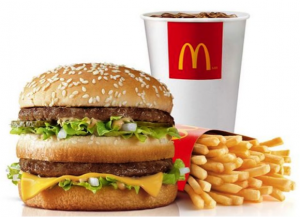Behavioral and Neural Valuation of Foods is Driven by Implicit Knowledge of Caloric Content Psychological Science | Deborah W. Tang, Lesley K. Fellows, Alain Dagher
Whether it’s your weekly routine, cheat day treat, or just out of total desperation we all have had our fair share of meals from McDonald’s, Burger King, Taco Bell and many more of these tempting fast food stops. However, while you were enjoying this deliciously greasy meal were you aware of what exactly,  or more importantly how much, you were putting in your body? The answer is most likely no. A simple take-out meal of a Big Mac, Medium Fry, and Sweet Tea from McDonald’s contains a whopping 1200 calories! General caloric recommendation is around 1500-1800 calories3, so with just one of these typical fast food meals you are nearly reaching your daily quota for calories, which is kind of terrifying. Over the past 30 years the obesity rate has nearly doubled2, with 34.9% of adults reporting as obese1, and a great deal of this is due to the easy and growing access to high-calorie “junk-foods”. Understanding why junk food tends to be desired and the implications of that on the brain can aid in mediating the massive obesity problem that the world, and specifically the U.S., is facing.
or more importantly how much, you were putting in your body? The answer is most likely no. A simple take-out meal of a Big Mac, Medium Fry, and Sweet Tea from McDonald’s contains a whopping 1200 calories! General caloric recommendation is around 1500-1800 calories3, so with just one of these typical fast food meals you are nearly reaching your daily quota for calories, which is kind of terrifying. Over the past 30 years the obesity rate has nearly doubled2, with 34.9% of adults reporting as obese1, and a great deal of this is due to the easy and growing access to high-calorie “junk-foods”. Understanding why junk food tends to be desired and the implications of that on the brain can aid in mediating the massive obesity problem that the world, and specifically the U.S., is facing.
In an effort to do this, researchers from McGill University put a group of healthy people through multiple tests using 50 images of familiar foods. The participants were tested on their willingness to buy each item using a bidding process, asked how much they liked each food, and were told to estimate the caloric content of each food. In order to link these results to activity in the brain, each test was done while the subject was in an fMRI machine.
The results of this were somewhat surprising. The true caloric density was a strong predictor of how much people were willing to pay for each food and was associated with the Ventromedial Prefrontal Cortex, an area involved with mediating control of conditioned motivation to eat. However, the estimated calorie content of each food had nearly no impact on the participants’ willingness to pay for each item and was linked with the insula, an area of the brain involved with processing sensory properties of food.
These results shed light on how the circuits of our brain that control motivated choice attribute value to food: valuation stems from implicit value rather than subjective value. This means that our preexisting experience with a food greatly affects how we value it. This research also suggests that our brain drives us to desire calorically dense foods; since a major factor in the obesity epidemic is the overconsumption of these foods, this is very important to understand. This insight could lead to more targeted and effective dieting strategies that could greatly improve the obesity problem and the research done by Tang, Dagher, and Fellows is a big step towards this understanding.
Tang, D. W., Fellows, L. K., & Dagher, A. (2014). Behavioral and Neural Valuation of Foods Is Driven by Implicit Knowledge of Caloric Content. Psychological Science, 25(12), 2168-2176. Retrieved February 5, 2016, from file:///Users/mtbledsoe/Downloads/Tang 2014 Psychol Sci (2).pdf.
References:
- Adult Obesity Facts. (2015, September 21). Retrieved February 27, 2016, from http://www.cdc.gov/obesity/data/adult.html
- Obesity Rates & Trends Overview. (2012). Retrieved February 27, 2016, from http://stateofobesity.org/obesity-rates-trends-overview/
- Muntel, S. (n.d.). Obesity Action Coalition » Fast Food – Is it the Enemy? Retrieved February 27, 2016, from http://www.obesityaction.org/educational-resources/resource-articles-2/nutrition/fast-food-is-it-the-enemy
Image Adapted from http://www.franchisechatter.com/2015/01/26/match-your-appetite-to-the-mcdonalds-menu/

